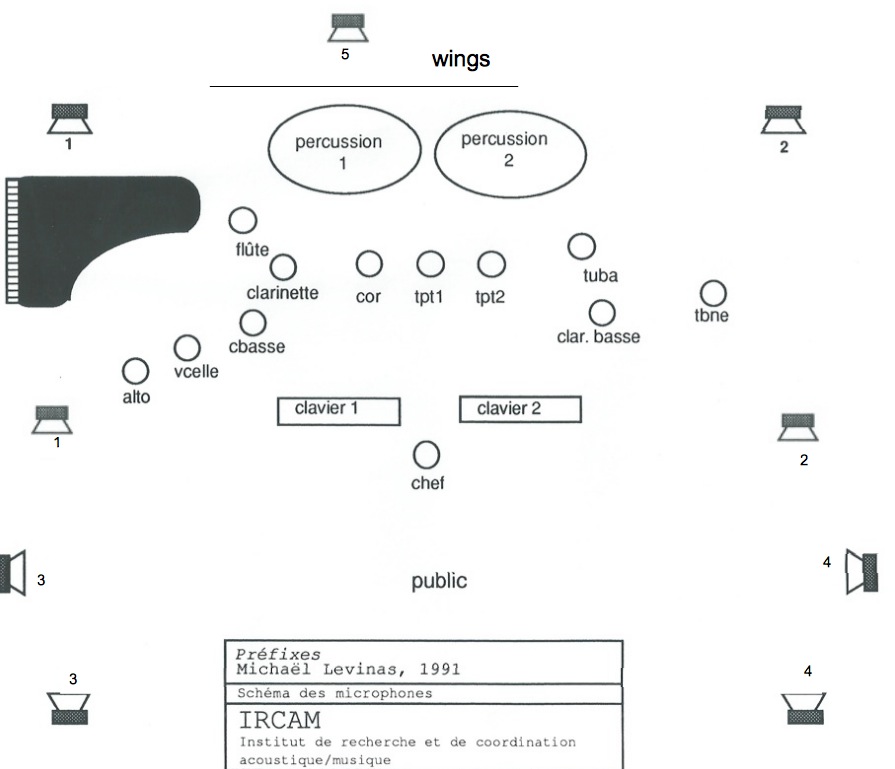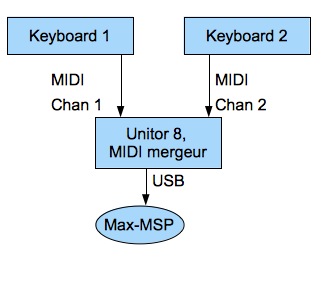Préfixes
MaxMSP6
Michaël Levinas
Outline
- Version Information
- Other Versions
- Detailed Staff
- Electronic Equipment List
- Work Related Information
- Downloads
- Instructions
action
Updated at
Vous constatez une erreur ?
The setup and the execution of the electroacoustic part of this work requires a Computer Music Designer (Max expert).
Version Information
- Documentation date
- 8 mai 2014
- Version
- MaxMSP6
- Status
- valid
- Validation date
- 3 mai 2018
- Documentalist
- pages (pages@ircam.fr)
- Realisation
- Michaël Levinas (Composer)
- Nicolas Verin (Computer Music Designer)
- Sandrine Pages (Documentalist)
- Length
- 15 min
- Upgrade motivation
- Ported from Syquest and samplor S2000 Soundfiles now in aiff format
- Comment
- Not tested in concert
Validated with Michael Levinas
Other Versions
Prefixes 2 - SCALAvalid24 juillet 2019
Doc Battierarchived1 janvier 1993
Detailed Staff
flute, alto flute, 2 clarinets, bass clarinet, horn, 2 trumpets, trombone, tuba, 2 percussionists, harp, piano, 2 electronic/MIDI keyboards/synthesizers, viola, cello, double bass
Detailed staff comes from Brahms, send mail to ressources-contenus@ircam.fr for correction.
Electronic Equipment List
Computer Music Equipment
- 2 KX 88
- MIDI Keyboard (Yamaha) - with 88 heavy touch keys and program change switches.
- 1 Unitor 8
- MIDI Interfaces (Emagic)
- 1 Sound Board
- Sound Board (generic) - minimum 5 audio outputs
- 2 Footswitch / Sustain Pedal
- Footswitch / Sustain Pedal (generic)
- 1 Max 6
- Max (Cycling74) - max 6.1.6 32bits or above
Audio Equipment
- 1 Mixing Console
- Mixing Console (generic) - 26 in, 9 out
- 9 Loudspeaker
- Loudspeakers (generic) - quadriphony + 1 in wings
- 3 Stage monitor
- Stage Monitors (generic) - optional, for the conductor and the 2 keyboard players
- 15 Microphone
- Microphone (generic) - cf Audio setup
Downloads
score
Levinas/Lemoine
97.69 Mo
commercial CD
Ensemble L'itinéraire/aeon
169.07 Mo
Max Sampler with sound files
1016.09 Mo
MIDISEtup
25.47 Ko
loudspeakers
81.34 Ko
midi
19.36 Ko
display
37.77 Ko
princ
67.88 Ko
pref
28.45 Ko
config
166.41 Ko
effects
29.13 Ko
rev
66.42 Ko
effects
29.13 Ko
presentation
81.71 Ko
Instructions
loudspeakers and instruments setup:
The loudspeaker "in the wings" can be in the wings if you can keep the door open. If you can't, you can put it under the audience or face to the back wall. What is important is that sounds from this loudspeaker seem to be far away from the audience.
MIDI configuration:
Caution: Put the keyboards in SINGLE, not in DUAL!
Keyboards are in OMNI for program keys, so the keyboard player who doesn't play can change the program. But the keyboard just show the program changed by itself, so in rehearsal, the computer music designer should do the program changes if one needs to go back.
Make sure that each keyboard is on a different channel.
Audio setup:
5 audio outputs (DACs) from MAX, no ADC.
Keyboard 1 sounds mostly in speakers 1 and 3, keyboard 2 in speakers 2 and 4.
For mics, this is what was used for the premiere:
15 microphones:
clarinet (2 mics or more, it needs to be everywhere, for the creation, a "DICKENSTEIN's system" was used)
bass clarinette (2mics)
and 1 mic for each other instruments
Software installation:
1) In Max 6, choose .../Préfixes_Lévinas_2014 in Option/File Preferences.
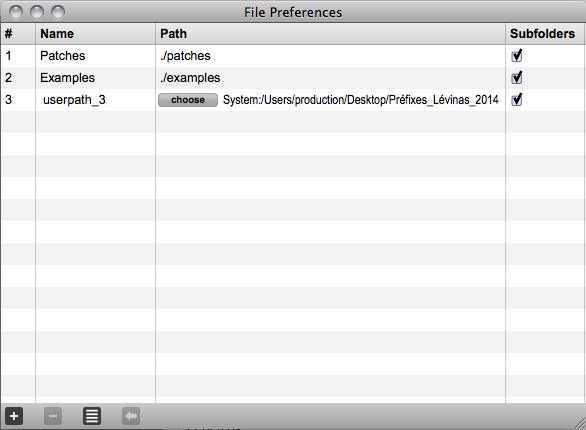
2) set Options/Audio Setup to
- Sampling rate = 44.1 khz
- IOvector Size 256 + Signal Vector Size = 64
- overdrive on + Scheduler in audio interrupt.
3) Close and reopen max to save preferences
4) Open the patch Préfixes2015.maxpat :
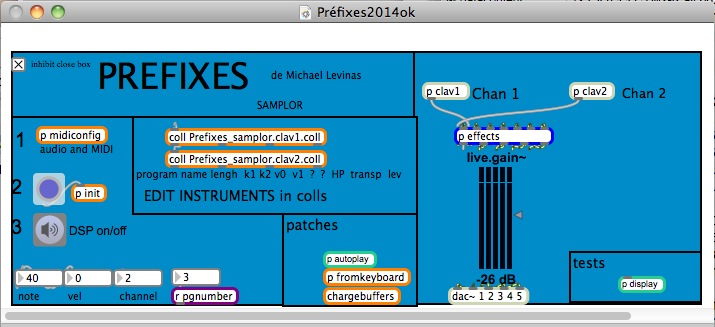
5) Choose your MIDI config in the patch by clicking on p midiconfig just under the title.
![]()
6) Bang on p init under p midiconfig
7) DSP On under p init
System calibration and tests:
To test the patch without keyboards:
1) Double click on p display on the right bottom corner:
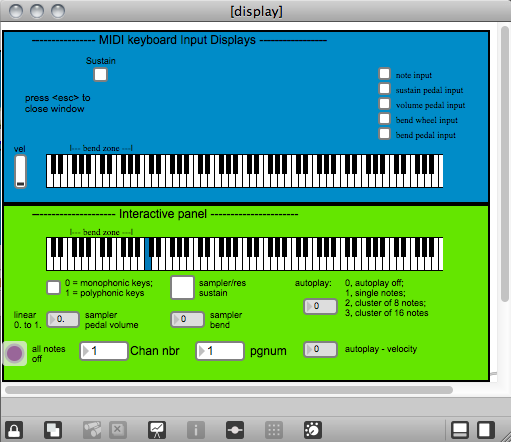
2) choose the channel and the program number in the green area and play the interactive panel.
Don't worry, some keys don't have any samples.
With the keyboards:
Check that you have chosen the good midiconfig (CF software installation):
- press keys of the two keyboards and check it's written sampleclav1 or sampleclav2 in max window,
- check the program change
- check the sustain pedal
Adapt to the hall :
When you click on p effect on the righ side of the main patch, there are EQ and reverb that you can adapt to the room acoustic.
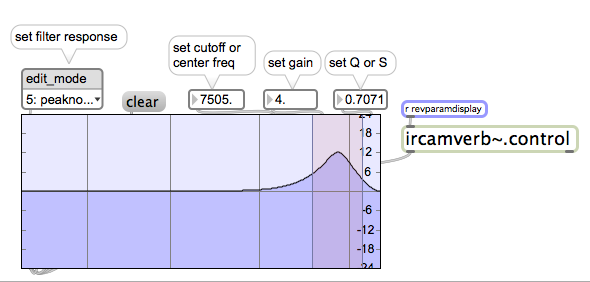
The EQ can be chosen graphically or with the int boxes on it.
By clicking on ircamverb~.control, you can adjust the reverberation:
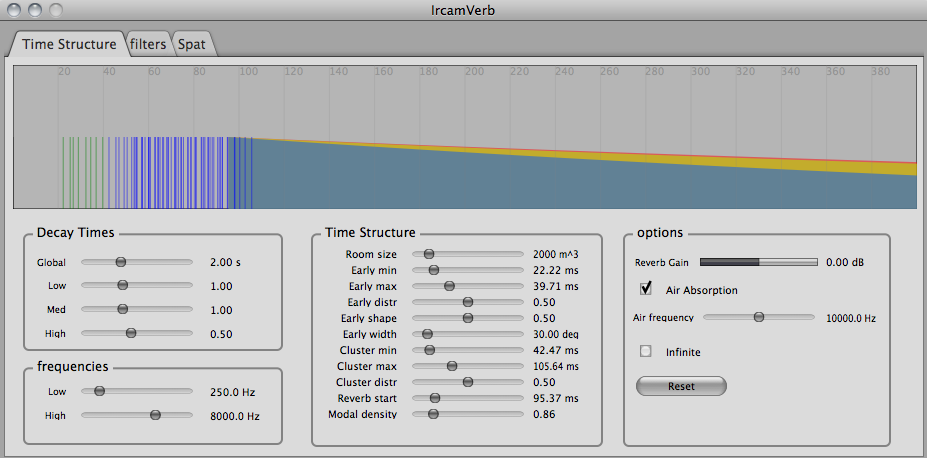
Initialization routine:
1) bang on p init
2) choose your program
Patch presentation:
This patch is a sampler. The sounds have been done by phase vocoder hybridation.
On the main window, you have different areas. How to use the init area and the display area is explained on software installation and system calibration and tests parts. The other explainations followed:
Edit instruments:
If you need to adjust some samples, you can do it by double clicking on the objects coll Prefixes_sample.clav1 et coll Prefixes_sample.clav2 and change what you need. The syntax is :
then save your coll and bang on init to validate your modifications.
Right part of the main patch:
It's the sampler and the effects. If you need more informations about the samplor~ object, see the helpfile in the prefixes folder or join Serge Lemouton who designed it (serge.lemouton@ircam.fr).
p clav#1 contains all the commands for the samplor
p effect is explained on system calibrations and tests .
You can see after the effects the output level of each output.
patches part of the main patch:
You can see in the chargebuffer object how the samples are loaded into max.
p fromkeyboard is the MIDI inputs
p autoplay allows the interactive keyboard to play alone.
Updated at
Vous constatez une erreur ?
IRCAM
1, place Igor-Stravinsky
75004 Paris
+33 1 44 78 48 43
heures d'ouverture
Du lundi au vendredi de 9h30 à 19h
Fermé le samedi et le dimanche
accès en transports
Hôtel de Ville, Rambuteau, Châtelet, Les Halles
Institut de Recherche et de Coordination Acoustique/Musique
Copyright © 2022 Ircam. All rights reserved.
